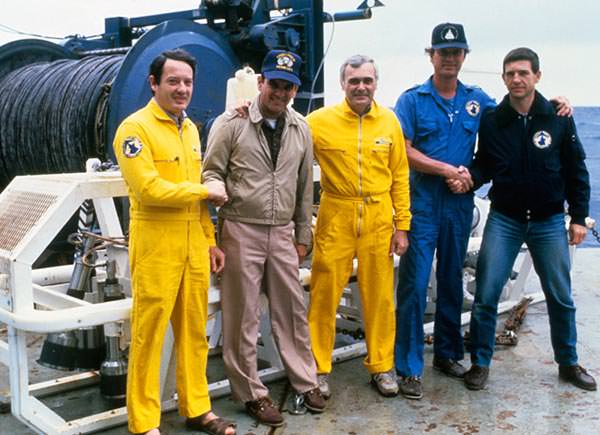01 September 1985 – the date on which the wreck of Titanic was located, the result of a joint French-American expedition headed up by Jean-Louis Michel of the French National Institute of Oceanography (IFREMER) and Robert Ballard of the Woods Hole Oceanographic Institution (WHOI).
50 – 100 feet – the typical height above the sea floor at which ‘Argo’, the deep-sea camera sled used to find Titanic, was towed. Argo, developed by the Deep Submergence Laboratory at WHOI, could illuminate the ocean bottom with strobes and continual lighting sources, and send video images back to the mother ship from an array of cameras.
15 feet – the length of Argo (3.5 feet tall and 3.5 feet wide).
4,000 lbs – the weight of Argo when not submerged.
73 – the number of years after the Titanic sank before the Titanic wreckage was found (73 years, 4 months, 17 days).
26,802 – the number of days after the Titanic sank that she was rediscovered.

Above: The team who found the Titanic. L-R: Jean-Louis Michel, Lt. George Ray, Jean Jerry, Robert Ballard, Bernard Pillaud. All members of the French National Institute of Oceanography (IFREMER) except Lt. George Ray (US Navy). Image credit: Woods Hole Oceanographic Institution.
12 July 1986 – the date on which Robert Ballard returned to the wreck site, using the submersible Alvin.
1987 – the year in which RMS Titanic, Inc. (RMST) based in Atlanta, Georgia, USA, was founded by G Michael Harris and George Tulloch, and began making dives to the Titanic.
$6,000,000 – the approximate cost of the initial RMST expedition.
32 – the number of dives conducted during the first expedition, using a deep-dive submersible called ‘Nautile’.
1994 – the year in which RMST was granted salvor-in-possession rights by the US Federal Court, giving the company the sole rights to remove artefacts.
Above: A talk given in 2012 by Robert Ballard, professor of oceanography at the University of Rhode Island, on his involvement in the discovery of the Titanic wreck.
6 – the number of expeditions launched by RMST between 1987 and 2000.
6,000 – the approximate number of artefacts recovered from the Titanic underwater during those 6 expeditions.
1998 – the year in which tourists were first able to use submersibles to dive to the site of the Titanic wreck.
$32,500 – the cost of the ticket for one of those first tourist dives.
10 August 1998 – the date that RMS Titanic, Inc. raised a section of the hull to the surface, and onto the deck of Abeille, the salvage vessel, against protests that the site where the Titanic sank was a sea grave.
It’s not a question of actually finding a bone. There are human remains in one form or another around that wreck, as well as all sorts of shattered lives directly associated with it. -Dan Conlin, Nova Scotia Maritime Museum
23 x 14 feet – the dimensions of the hull section – known as the ‘Big Piece’.
15 tons – the weight of the Big Piece section.
2.4 miles – the depth at which the hull section (and the rest of the wreckage) was located.
6,000 – the water pressure at the depth where Titanic is located, measured in pounds per square inch (410 bar).
40 minutes – the time it took to raise the hull section to the surface.
1996 – the year the company first attempted to raise this section, unsuccessfully.
C-79 and C-81 – the First Class cabins that the Big Piece contained (part of the starboard side of C Deck).
Did You Know?
In August and September of 2010, the first complete picture of the Titanic wreckage was produced, by the Woods Hole Oceanographic Institution (WHOI). Sweeping an area of ocean floor 3 miles wide by 5 miles long, 3 robotic vehicles took hundreds of images a second, as well as using side-scan and multi-beam sonar, to allow a mosaic to be created which reveals the wreck site in a complete view.
More To Explore
If you have found these facts about the team who found the Titanic interesting, you might also be interested in our pages on the sinking of the Titanic, a detailed account of where the Titanic sank, and in our facts about the Titanic wreckage.
